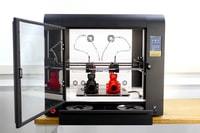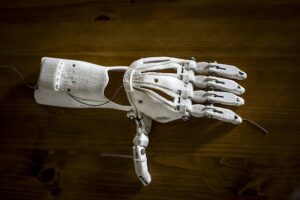Your Comprehensive Guide to Additive Manufacturing
A 3D printer is an additive manufacturing machine that builds three-dimensional objects layer by layer from a digital file. Instead of cutting or carving material away like traditional methods, a 3D printer adds material only where it’s needed. This makes it ideal for rapid prototyping, custom parts, and complex shapes that are difficult or expensive to produce any other way.

Not long ago, 3D printing felt like something from a sci-fi movie. It seemed too expensive, too slow, or too complicated for everyday use. However, things have changed. Today, 3D printers are on desks, in garages, in classrooms, and on factory floors. They help people move from idea to physical object much faster than traditional methods.
On this page, we will walk through what a 3D printer is, how it works, what you can do with one, and how to decide if you need one in your home, school, or business. If you want to go deeper after this article, you can also explore my beginner-friendly Foundations of 3D Printing guide.
How Does a 3D Printer Work?
At its core, a 3D printer follows a simple idea: take a digital design and build it up one thin layer at a time.
Here’s what happens behind the scenes:
- You start with a 3D model. This is usually created in CAD software or downloaded from a model library. If you want to learn this step, I have a guide on how to create 3D models in just 20 minutes.
- The model is sliced into layers. Slicer software takes your model and turns it into hundreds or thousands of flat layers, plus a toolpath the printer can follow.
- The printer builds each layer in order. Depending on the technology, it will either melt and lay down plastic, cure liquid resin with light, or fuse powder with a laser.
- The layers stick together. As each new layer is added, it bonds to the one below it, and the object slowly appears on the build plate.
This entire process is called additive manufacturing because material is added instead of removed. It’s the opposite of subtractive manufacturing, where you cut away from a block of material with a mill, lathe, or CNC router.
Two Common 3D Printing Technologies
There are many 3D printing technologies, but two are especially common in homes, schools, and small businesses:
- Fused Deposition Modeling (FDM): This is the style most people think of when they picture a desktop 3D printer. The machine feeds a plastic filament into a hot nozzle, melts it, and draws each layer one line at a time. As the plastic cools, it hardens and forms your part.
- Resin Printing (SLA / MSLA): Resin printers use liquid photopolymer resin in a vat. Light (often from an LCD and UV LEDs) cures each layer at once. This method can capture very fine details and smooth surfaces, which makes it popular for miniatures and small, precise parts.

If you want to see a broader overview of printer types—including SLS and other advanced methods—take a look at my guide on the different types of 3D printers.
What Materials Can a 3D Printer Use?
When people first see a 3D printer, they usually assume it only prints in one kind of plastic. However, modern 3D printers work with a wide range of materials, depending on the technology you choose.
- Common plastics: PLA, PETG, ABS, ASA, Nylon, and flexible materials like TPU.
- Resins: Standard, tough, flexible, high-temperature, and even dental or engineering-grade resins.
- Metals: With advanced systems, powders like stainless steel, titanium, or aluminum can be fused into metal parts.
- Ceramics: Used for art, design, and functional pieces that can be fired like traditional ceramic work.
- Composite materials: Plastics and resins reinforced with carbon fiber, glass, or other additives for extra strength.
- Biomaterials: In research settings, certain printers can even work with biological materials to explore tissue and organ applications.

This range of materials is one of the reasons 3D printing is so powerful. You can move from simple plastic prototypes to functional components, jigs and fixtures, and even end-use parts.
How Fast Can a 3D Printer Print?
“How long will my print take?” is one of the most common questions I hear. The honest answer is: it depends. However, once you understand what affects print time, the estimates start to make sense.
- Model size: Larger parts take longer because the printer has more layers to build.
- Complexity: Detailed shapes, curves, and internal structures can add time.
- Layer height: Thinner layers mean smoother prints but more layers overall.
- Print speed settings: Faster speeds save time but may reduce quality if pushed too far.
- Printer type: Some modern high-speed machines are dramatically faster than older designs.
Even with those variables, 3D printing is usually fast enough for rapid prototyping and on-demand parts. In fact, high-speed printers like the Creality K1C are raising the bar for how quickly you can move from design to finished print.
Who Uses 3D Printers—and Why?
3D printers are no longer limited to labs or big companies. They show up in more places each year because they solve real problems in practical ways.
- Product designers and engineers: Quickly test new ideas, check fit and function, and refine designs without waiting weeks for parts.
- Small businesses: Create custom fixtures, replacement parts, packaging tools, and even small production runs.
- Educators and students: Bring STEM projects to life and teach design, problem-solving, and creativity.
- Makers and hobbyists: Build gadgets, models, upgrades for tools, and custom parts for everyday life.
- Artists and architects: Turn digital models into physical sculptures, concept pieces, and scale models.
- Medical and dental professionals: Produce custom models, guides, and parts tailored to individual patients.

Because 3D printing is so flexible, it often becomes a “Swiss Army knife” tool. Once you have access to a capable printer, you start seeing everyday problems you can solve with custom parts.
Do You Really Need a 3D Printer?
Not everyone needs to own a 3D printer—but many people can benefit from one.
You might want your own printer if you:
- Love designing or tinkering and want to bring ideas to life at home.
- Run a small business and need custom parts, fixtures, or packaging helpers.
- Teach or learn in a STEM environment and want hands-on projects.
- Enjoy hobbies like tabletop gaming, scale models, cosplay, or DIY repairs.
On the other hand, if you only need a part printed once in a while, it might be easier and more cost-effective to use a 3D printing service. That way, you get professional results without maintaining the equipment yourself.

If you’re curious but not ready to commit, you can always start by sending a project through my custom 3D printing services and see what is possible.
How to Choose the Right 3D Printer
Choosing a 3D printer is easier when you start with your goals instead of the latest hype. Ask yourself a few key questions:
- What do I want to print? Functional parts, miniatures, art pieces, or a mix?
- How big do my parts need to be? Your required build volume affects which machines make sense.
- What materials do I care about? PLA and PETG are great starters; resin is better for small details.
- How much time do I want to spend tinkering? Some printers are “plug-and-play,” while others require more tuning.
- What is my budget? Costs range from a few hundred dollars for beginners to thousands for advanced systems.
To help you narrow things down, I’ve put together a guide to the best 3D printers for beginners and growing makers. It covers real-world pros and cons, not just spec sheets.
Ready to explore 3D printers for your home, workshop, or small business?
The market offers a wide range of machines—from compact beginner-friendly printers to advanced models designed for speed and reliability. Take your time, compare options, and choose the one that fits your projects, not just the trend of the week.
Shop Creality 3D printers and find a model that matches your goals.
Where to Go Next on Your 3D Printing Journey
Now that you know what a 3D printer is and how it works, you’re ready to take the next step. You don’t have to learn everything at once. Instead, move one layer at a time—just like the printer itself.
- Start with the Foundations of 3D Printing to understand the basics.
- Explore 3D printer reviews to see how different machines compare in real use.
- Dive into step-by-step guides on bed leveling, slicer settings, materials, and troubleshooting.
We would love to know what you think. If you have a moment, please leave a comment or question below. Your feedback helps us improve everything we do.

